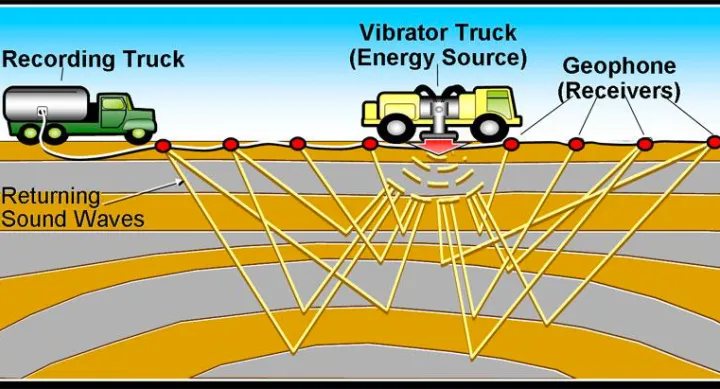
Land-based oil exploration is heavily reliant on the vibroseis method of using swept frequency, and high force, wave propagation and detection to enable mapping of the sub-surface earth structure. When a pressure wave travels through solid, liquid, or gas, part of the wave reflects wherever a change in the underground formation occurs. A reflection seismic survey creates and measures “echos” from a below the ground. These reflections are measured with instruments known as geophones placed at the surface of the earth and the time of arrival of each wave creates a picture of the subsurface.
Current Vibrator Trucks in the field use hydraulic systems to generate force waves. However, the hydraulic approach has many inherent technical limitations, which result in poor harmonic fidelity of the source wave. Reflection of the harmonic waves off of underground geologic features clouds the returning signals and distorts the map. For most vibrators in use today, hydraulic pumps are incapable of delivering adequate flow for long dwell and low frequency linear sweeps, even at reduced drive levels. Hydraulic technology is mature and improvements are incremental.
CEM researchers are advancing exploration technology by developing a new system capable of low frequency (1 to 5 Hz) waves for better mapping resolution. CEM has successfully designed, fabricated, and testing the electromagnetic transducer (E-VIBE) shown in Figure 1.

Figure 1. Electromagnetic Transducer (E-VIBE)
This system increases the fidelity of a signal transmitted into the ground for use in seismic exploration. This was accomplished by designing an electromagnetic (EM) voice coil transducer capable of producing 60,000 lb of force in the frequency range of 2 to 125 Hz. The low frequency, high harmonic purity, seismic waves of the E-VIBE system can reduce the time required to complete a field survey for oil deposits, resulting in significant economic benefit.
The success of the program was demonstrated in head to head field testing of the E-VIBE and an AHV-IV 363 INOVA hydraulic vibrator. At 2 Hz, the E-VIBE has 3% total harmonic distortion, whereas the hydraulic vibe has an order of magnitude greater distortion at 30% distortion. In a relatively new vibrator function, random phase sweep, the E-VIBE was able to follow the command signal, whereas the hydraulic vibe struggled to follow the rapidly changing demand wave. This new sweep methodology has the promise of greatly reducing survey time with the subsequent economic benefit.
Simple analysis of the vibrator driven mass system shows that the force produced in the ground is proportional to the mass, frequency squared, and the total stroke of the vibrator. Mass is limited by what can be transported and moved over the mapping site, low frequency is desired to penetrate deep into the structure, this leaves a long stroke required to produce large force at the low frequency. The voice coil actuator stroke is limited by the resultant mass required to wrap the iron magnetic circuit around the force coil. A new magnetic topology that decouples the mass from the allowed stroke is being analyzed for the next generation device and is the focus of future research.
Contact

Dr. Raymond C. Zowarka
r.zowarka@cem.utexas.edu
512-232-1612
Projects

Vibroseis Research
CEM advanced seismic exploration technology by developing a new EM transducer

Paraffin Heater
CEM assisted UT-PGE in prototype fabrication and testing of a new technology to clear paraffin wax buildup in a drill string without the need for an external power supply.


